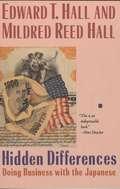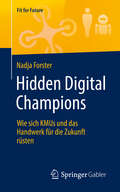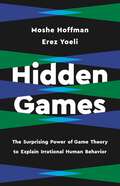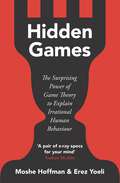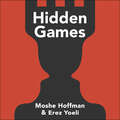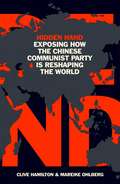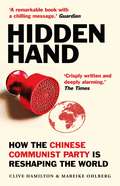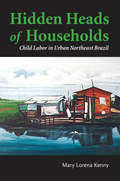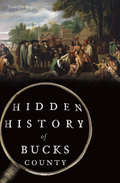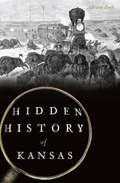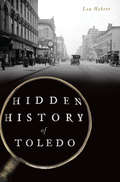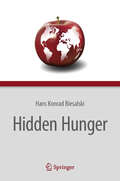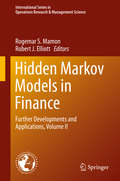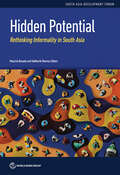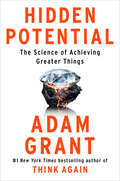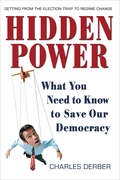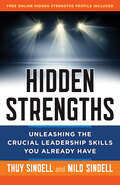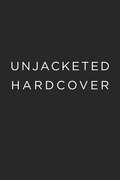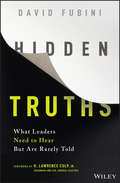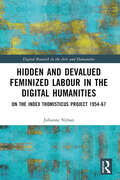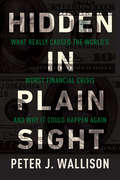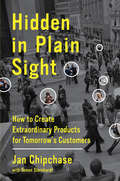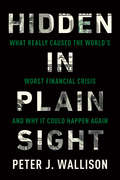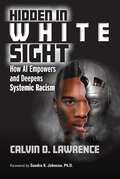- Table View
- List View
Hidden Differences: Doing Business With The Japanese
by Edward T. Hall Mildred Reed HallAn analysis and explanation of the unstated rules of Japanese-American business relations. By drawing Western readers into the world in which they must function, the Halls simplify the process of adapting Western ways to a new environment.
Hidden Digital Champions: Wie sich KMUs und das Handwerk für die Zukunft rüsten (Fit for Future)
by Nadja ForsterDer digitale Wandel trifft jedes Unternehmen. Er ist kein Hype oder Trend mehr, sondern mittlerweile Fakt. In der heutigen Zeit reicht es nicht mehr aus, sich mit Prozessoptimierungen oder minimalen Produktanpassungen auseinanderzusetzen. Die Megatrends der Zukunft zeigen, dass die digitale Transformation in die Geschäftsstrategie der Unternehmen integriert werden muss. Neues Denken und neues Handeln ist gefragt. Konkrete Handlungs- und Umsetzungsbeispiele liefert Ihnen dieses Fachbuch. Neben den künftigen Entwicklungen zeigt das Buch zudem auf, welche Veränderungsfelder in den unternehmerischen Fokus rücken müssen, um langfristig am Markt bestehen zu bleiben. Das muss nicht immer mit einem kompletten Wandel einhergehen. Digital Hidden Champions beweisen, dass man auch mit kleinen Schritten mit der Zeit gehen kann.Über die Reihe Fit for FutureDie Zukunft wird massive Veränderungen im Arbeits- und Privatleben mit sich bringen. Tendenzen gehen sogar dahin, dass die klassische Teilung zwischen Arbeitszeit und Freizeit nicht mehr gelingen wird. Eine neue Zeit – die sogenannte „Lebenszeit“ – beginnt. Laut Bundesregierung werden in den nächsten Jahren viele Berufe einen tiefgreifenden Wandel erleben und in ihrer derzeitigen Form nicht mehr existieren. Im Gegenzug wird es neue Berufe geben, von denen wir heute noch nicht wissen, wie diese aussehen oder welche Tätigkeiten diese beinhalten werden. Betriebsökonomen schildern mögliche Szenarien, dass eine stetig steigende Anzahl an Arbeitsplätzen durch Digitalisierung und Robotisierung gefährdet sind. Die Reihe „Fit for future“ beschäftigt sich eingehend mit dieser Thematik und bringt zum Ausdruck, wie wichtig es ist, sich diesen neuen Rahmenbedingungen am Markt anzupassen, flexibel zu sein, seine Kompetenzen zu stärken und „Fit for future“ zu werden. Der Initiator der Buchreihe Peter Buchenau lädt hierzu namhafte Experten ein, ihren Erfahrungsschatz auf Papier zu bringen und zu schildern, welche Kompetenzen es brauchen wird, um auch künftig erfolgreich am Markt zu agieren. Ein Buch von der Praxis für die Praxis, von Profis für Profis. Leser und Leserinnen erhalten „einen Blick in die Zukunft“ und die Möglichkeit, ihre berufliche Entwicklung rechtzeitig mitzugestalten.
Hidden Games: The Surprising Power of Game Theory to Explain Irrational Human Behavior
by Erez Yoeli Moshe HoffmanTwo MIT economists show how game theory—the ultimate theory of rationality—explains irrational behavior We like to think of ourselves as rational. This idea is the foundation for classical economic analysis of human behavior, including the awesome achievements of game theory. But as behavioral economics shows, most behavior doesn&’t seem rational at all—which, unfortunately, to cast doubt on game theory&’s real-world credibility. In Hidden Games, Moshe Hoffman and Erez Yoeli find a surprising middle ground between the hyperrationality of classical economics and the hyper-irrationality of behavioral economics. They call it hidden games. Reviving game theory, Hoffman and Yoeli use it to explain our most puzzling behavior, from the mechanics of Stockholm syndrome and internalized misogyny to why we help strangers and have a sense of fairness. Fun and powerfully insightful, Hidden Games is an eye-opening argument for using game theory to explain all the irrational things we think, feel, and do.
Hidden Games: The Surprising Power of Game Theory to Explain Irrational Human Behaviour
by Erez Yoeli Moshe Hoffman'Packed with fresh and clear insights that will change the way you think about the world' Uri Gneezy'One of those books that you pick up and then can't put down' Steve Stewart-Williams'This is a book I will come back to again and again' Nichola RaihaniHow game theory - the ultimate theory of rationality - explains irrational behaviour.In Hidden Games, MIT economists Moshe Hoffman and Erez Yoeli find a surprising middle ground between the hyperrationality of classical economics and the hyper-irrationality of behavioural economics. They call it hidden games. Reviving game theory, Hoffman and Yoeli use it to explain our most puzzling behaviour, from the mechanics of Stockholm syndrome and internalised misogyny to why we help strangers and have a sense of fairness.Fun and powerfully insightful, Hidden Games is an eye-opening argument for using game theory to explain all the irrational things we think, feel, and do and will change how you think forever.
Hidden Games: The Surprising Power of Game Theory to Explain Irrational Human Behaviour
by Erez Yoeli Moshe Hoffman'Packed with fresh and clear insights that will change the way you think about the world' Uri Gneezy'One of those books that you pick up and then can't put down' Steve Stewart-Williams'This is a book I will come back to again and again' Nichola RaihaniHow game theory - the ultimate theory of rationality - explains irrational behaviour.In Hidden Games, MIT economists Moshe Hoffman and Erez Yoeli find a surprising middle ground between the hyperrationality of classical economics and the hyper-irrationality of behavioural economics. They call it hidden games. Reviving game theory, Hoffman and Yoeli use it to explain our most puzzling behaviour, from the mechanics of Stockholm syndrome and internalised misogyny to why we help strangers and have a sense of fairness.Fun and powerfully insightful, Hidden Games is an eye-opening argument for using game theory to explain all the irrational things we think, feel, and do and will change how you think forever.(P) 2022 Hodder & Stoughton Limited
Hidden Hand: Exposing How the Chinese Communist Party is Reshaping the World
by Clive Hamilton Mareike OhlbergThe Chinese Communist Party is determined to reshape the world in its image. The party is not interested in democracy. It sees only a bitter ideological struggle with the West, dividing the world into those who can be won over, and enemies. Many political and business elites have already been lured to their corner; others are weighing up a devil&’s bargain. Through its enormous economic power and covert influence operations, China is now weakening global institutions, aggressively targeting individual corporations, and threatening freedom of expression from the arts to academia. At the same time, Western security services are increasingly worried about incursions into our communications infrastructure. In a landmark study combining meticulous research with unique insights, Hidden Hand exposes the Chinese Communist Party&’s global program of subversion, and the threat it poses to democracy. We have already missed too many warning signs – now it is time to wake up.
Hidden Hand: Exposing How the Chinese Communist Party is Reshaping the World
by Clive Hamilton Mareike OhlbergThe Chinese Communist Party is determined to reshape the world in its image. The party is not interested in democracy. It sees only a bitter ideological struggle with the West, dividing the world into those who can be won over, and enemies. Many political and business elites have already been lured to their corner; others are weighing up a devil&’s bargain. Through its enormous economic power and covert influence operations, China is now weakening global institutions, aggressively targeting individual corporations, and threatening freedom of expression from the arts to academia. At the same time, Western security services are increasingly worried about incursions into our communications infrastructure. In a landmark study combining meticulous research with unique insights, Hidden Hand exposes the Chinese Communist Party&’s global program of subversion, and the threat it poses to democracy. We have already missed too many warning signs – now it is time to wake up.
Hidden Heads of Households: Child Labor In Urban Northeast Brazil (Teaching Culture: Utp Ethnographies For The Classroom Ser.)
by Mary Lorena KennyIn the cities of Northeast Brazil where 50 per cent of the population lives in poverty, children play a key role in the local economy—in their households, in formal jobs, and in the thriving informal sector (washing cars, shining shoes, scavenging for recyclables, etc.). Why children migrate to the city, how they negotiate their existence, and why they stay are just some of the questions addressed in this fascinating study. Mary Kenny spent close to 15 years in the urban areas of Northeast Brazil talking with and interviewing children. She even gave them disposable cameras to document their daily lives (many of the photographs they took are included). Rather than lament a lost childhood, or try to save these children, Kenny explores some of the complex conditions under which these children work and live. She illustrates how unrelenting scarcity shapes family and, by extension, children's options, decisions, and worldviews. The issues raised in this book are of critical importance. There are no easy answers, but listening to how these children define themselves and their circumstances is an important step towards understanding and ultimately solving economic and social inequality.
Hidden History of Bucks County (Hidden History)
by Jennifer RogersBucks County was an original county in William Penn's newly formed Pennsylvania province and has carried the weight of history ever since. Industrial power in the region expanded in the late 1700s as Irish laborers sacrificed life and limb to construct a section of the Pennsylvania Canal and the Durham Furnace. In 1921, a gruesome train wreck claimed the lives of twenty-seven people, forever leaving its tragic mark on the busy rail lines emerging from Philadelphia. Raised a Quaker in Doylestown, James A. Michener went from local English teacher to Pulitzer Prize-winning author, leaving his philanthropic mark at the art museum named for him. Join author Jennifer Rogers as she recounts the lesser-known history of Bucks County.
Hidden History of Kansas (Hidden History)
by Adrian ZinkKansas’ storied past is filled with fascinating firsts, humorous coincidences and intriguing characters. A man who had survived a murderous proslavery massacre in 1858 hanged his would-be executioner five years later. A wealthy Frenchman utilized his utopian ideals to create an award-winning silk-producing commune in Franklin County. A young boy’s amputated arm led to the rise of Sprint Corporation. The first victim of the doomed Donner Party met her end in Kansas. In 1947, a housewife in Johnson County, indignant at the poor condition of the local school for black children, sparked school desegregation nationwide. Author and historian Adrian Zink digs deep into the Sunflower State’s history to reveal these hidden and overlooked stories.
Hidden History of Toledo (Hidden History)
by Lou HebertToledo's history as a frontier town turned manufacturing powerhouse is well known. However, few know that it was once home to a champion racehorse that galloped into the record books. Many are unaware that East Toledo's verdant urban woodlands sprang from the work of just one man or that a local girl's meteoric rise in Golden Age Hollywood saw her play alongside Groucho Marx. Fewer still have heard of Officer Dell Hair, crime fighter and rhyme maker who walked the beat and walked into the history books as a celebrated cop-poet. These tales and more await as award-winning local broadcaster Lou Hebert shines a light into the forgotten corners of Glass City history.
Hidden Hunger
by Hans Konrad Biesalski Patrick O'MealyHidden Hunger is an increasing problem even in developed countries, whose potential negative consequences on long-term health are often overlooked and underestimated. Chronic malnutrition is at the core of the global hunger challenge facing science, politics, and economics. In plain language and with moving examples, Hans K. Biesalski describes how hidden hunger affects human health long before malnutrition becomes obvious. Worldwide, over one third of deaths among children under 5 years of age is associated with malnutrition. As poverty is the main reason for hidden hunger, addressing this dire challenge requires long-term policies. Land grabbing and climate change seriously counteract a lot of efforts to overcome hidden hunger. This book is a highly impressive call to action. Investment in agriculture and in particular in small-scale farmers to improve subsistence farming are among the approaches suggested to reach a sustainable solution. The author is head of the department of biochemistry and nutrition and managing director of the Food Security Center at the University of Hohenheim, Germany. He is a member of numerous advisory and expert groups for the World Health Organization (WHO), the Food and Agriculture Organization (FAO) and the Global Forum on Food Security and Nutrition.
Hidden Markov Models in Finance
by Rogemar S. Mamon Robert J. ElliottSince the groundbreaking research of Harry Markowitz into the application of operations research to the optimization of investment portfolios, finance has been one of the most important areas of application of operations research. The use of hidden Markov models (HMMs) has become one of the hottest areas of research for such applications to finance. This handbook offers systemic applications of different methodologies that have been used for decision making solutions to the financial problems of global markets. As the follow-up to the authors' Hidden Markov Models in Finance (2007), this offers the latest research developments and applications of HMMs to finance and other related fields. Amongst the fields of quantitative finance and actuarial science that will be covered are: interest rate theory, fixed-income instruments, currency market, annuity and insurance policies with option-embedded features, investment strategies, commodity markets, energy, high-frequency trading, credit risk, numerical algorithms, financial econometrics and operational risk. Hidden Markov Models in Finance: Further Developments and Applications, Volume II presents recent applications and case studies in finance and showcases the formulation of emerging potential applications of new research over the book's 11 chapters. This will benefit not only researchers in financial modeling, but also others in fields such as engineering, the physical sciences and social sciences. Ultimately the handbook should prove to be a valuable resource to dynamic researchers interested in taking full advantage of the power and versatility of HMMs in accurately and efficiently capturing many of the processes in the financial market.
Hidden Messages Managers Send
by Michael B. MccaskeyManagers enhance their understanding of communication by attending to images, settings, and body language. The imagery people use in their speech offers important clues regarding the world they inhabit. Because words are symbols, their meaning varies greatly depending on who is using them. A failure to understand this often results in misunderstandings between managers. The use of concrete as opposed to abstract words, of joking as a method of communicating risky statements, and of "I" rather than "we," often reveals important clues to meaning as does labeling, certain question-asking techniques, and evidence of either-or thinking.
Hidden Potential: Rethinking Informality in South Asia (South Asia Development Forum)
by Maurizio Bussolo and Siddharth SharmaInformality remains widespread in South Asia despite decades of economic growth. The low earnings and high vulnerability in the informal sector make this a major development issue for the region. Yet, there is no consensus on its causes and consequences, with the debate polarized between a view that informality is a problem of regulatory evasion and should be eradicated, and another that equates informality with economic exclusion. Recent advances in analyzing informality as the outcome of firm dynamics in distorted economic environments can help reconcile them. Building on these advances, the approach adopted in this volume clarifies that there are different types of informality, with different drivers and consequences. The report has four main messages that underscore the need for a multipronged strategy. First, informality in South Asia is dominated by firms that happen to be outside the purview of regulations because they are small, as opposed to those that remain small to escape regulations. Second, reforms of business regulations tend to have small direct effects on the informal sector, although they could have sizable indirect impacts on it if they succeed in removing major inefficiencies in the broader economy. Third, e-commerce platforms offer new opportunities to informal firms and workers, but many of them lack complementary skills or credit to benefit from such technologies. Fourth, a combination of contributory and non-contributory programs recognizing the heterogenous saving capacities of informal workers may be necessary to achieve more universal coverage of social insurance.
Hidden Potential: The Science of Achieving Greater Things
by Adam Grant#1 New York Times Bestseller&“This brilliant book will shatter your assumptions about what it takes to improve and succeed. I wish I could go back in time and gift it to my younger self. It would&’ve helped me find a more joyful path to progress.&” —Serena Williams, 23-time Grand Slam singles tennis championThe #1 New York Times bestselling author of Think Again illuminates how we can elevate ourselves and others to unexpected heights.We live in a world that&’s obsessed with talent. We celebrate gifted students in school, natural athletes in sports, and child prodigies in music. But admiring people who start out with innate advantages leads us to overlook the distance we ourselves can travel. We underestimate the range of skills that we can learn and how good we can become. We can all improve at improving. And when opportunity doesn&’t knock, there are ways to build a door.Hidden Potential offers a new framework for raising aspirations and exceeding expectations. Adam Grant weaves together groundbreaking evidence, surprising insights, and vivid storytelling that takes us from the classroom to the boardroom, the playground to the Olympics, and underground to outer space. He shows that progress depends less on how hard you work than how well you learn. Growth is not about the genius you possess—it&’s about the character you develop. Grant explores how to build the character skills and motivational structures to realize our own potential, and how to design systems that create opportunities for those who have been underrated and overlooked.Many writers have chronicled the habits of superstars who accomplish great things. This book reveals how anyone can rise to achieve greater things. The true measure of your potential is not the height of the peak you&’ve reached, but how far you&’ve climbed to get there.
Hidden Power: What You Need to Know to Save Our Democracy
by Charles DerberPolitical parties and elections are increasingly political theatre, with real power hidden behind a smokescreen of propaganda, carefully manipulated cultural and religious wars, and voting rituals. But there is another kind of hidden power in America: the grassroots social movements working for progressive change. If the Democratic Party can ally with these movements, America can be returned to its people. Derber sees American history as a succession of regimes, each spanning several administrations. Since the end of the Civil War, regimes of hidden power, in which corporate interests control both parties behind the scenes, have alternated with more open, inclusive and democratic regimes. Derber details how and why these hidden power systems finally collapsed and what determined the types of regimes that succeeded them. Hidden Power reveals how the current regime, possibly the most corporate in history, has maintained power by intensifying the red/blue culture wars, supporting religious extremists, exploiting terrorism fears, and manipulating the electoral process. Will this latest corporate regime be replaced by one that is more progressive? Or it could turn even further right and yield to something even worse, a uniquely American form of fascism? The best hope for positive change lies in an alliance between the Democratic Party and the grass roots progressive movements that, Derber shows, have always been the catalysts for change. Hidden Power concludes with an impassioned argument for why this would be in the Democrats' best interests, as well as the country's, and a detailed program for exactly how to go about it. Thoughtful, eloquent, and compelling, Hidden Power offers real hope for restoring genuine democracy to America.
Hidden Strengths: Unleashing the Crucial Leadership Skills You Already Have
by Milo Sindell Thuy SindellBuild a Foundation for Continual GrowthIn today's turbulent world you need to continually develop new skills to remain agile and adaptive—otherwise, your strengths will become crutches. But contrary to what many people believe, the best way to develop new skills isn't working on your weaknesses—it's identifying and elevating the underdeveloped abilities that lie between your weaknesses and your strengths. Books like StrengthsFinder 2.0 have helped leaders build on what they're best at—but they stop there. If you only go that far you're missing a huge opportunity for professional growth. Leading Silicon Valley consultants Thuy and Milo Sindell argue that relying exclusively on your top abilities can actually hold you back—it's critical that you expand your repertoire of skills. The most effective way to do that is find your hidden strengths—midlevel skills that can quickly be elevated into learned strengths with attention and focus. This book shows you how.Too many people waste their time working on their weaknesses, say the Sindells. Although focusing on shoring up weaknesses on the surface makes sense, they've found that it takes too much time and effort—the ROI just isn't there. The neglected skills in the middle, neither strengths nor weaknesses, are where the most potent development opportunities lie. They're close enough to being strengths that putting your energy there can offer a fast and powerful payoff. Us the Sindells' free online Hidden Strengths Assessment, along with the exercises and case studies in the book, you'll be able to identify your most promising hidden strengths and create a plan to turn them into major assets. In today's work environment, not growing and stretching yourself translates into lack of innovation, stagnation, and obsolescence. You can't keep leaning on the things you're naturally good at or your strengths will become training wheels. But with the Sindells' help, you'll continually develop new skills that will keep you riding at the front of the pack.
Hidden Talent: The Emergence of Hollywood Agents
by Tom KemperThis is a history of Hollywood agents as they rose in the studio system in the late 1920s and early 1930s up through the 1940s, demonstrating the central role they played in the classical Hollywood period. Includes bibliographical references and index.
Hidden Truths: What Leaders Need to Hear But Are Rarely Told
by David FubiniPRAISE FOR HIDDEN TRUTHS "A must-read for new and aspiring CEOs who want to minimize pitfalls and maximize their impact. David Fubini leverages his 35+ years of experience working with CEOs to bring us concrete, real life, very practical, and insightful advice." —HUBERT JOLY, former Chairman and CEO, Best Buy "David has written an essential guide for the new CEO. Whether you are leading a public corporation or a major arts organization, Hidden Truths takes a productive approach to some of the most fundamental challenges of the role. David's counsel is practical, positive, and deeply relevant for all new leaders." —MEREDITH "MAX" HODGES, Executive Director, Boston Ballet "A McKinsey veteran writes yet another high-minded leadership book—pass the espresso with a 5-hour ENERGY chaser, right? Wrong. David Fubini takes readers behind the C-suite scenes at some of the best-known institutions in America, revealing the vulnerabilities of their leaders and their pragmatic, deeply human insights about how to drive change and achieve success. This isn't a book about theory. It's a book about reality, one in which striking access combines with hard-earned wisdom." —BRIAN MCGRORY, Editor, Boston Globe "Hidden Truths gives a unique, behind-the-scenes look at what the reality of leadership feels and looks like. Having experienced the challenge of leadership in military, academic, and business contexts I can readily say there are many important lessons learned for leaders of all types in this book." —ADMIRAL JAMES STAVRIDIS, USN, former Supreme Allied Commander, NATO "David Fubini has produced a practical, insightful, and engaging book. He has used his years of consulting access to see 'behind the curtain' and showcase the very real, day-to-day complexities and challenges of being a CEO. He offers powerful and timely suggestions for leaders of all types of organizations." —DOUG PARKER, Chairman and CEO, American Airlines "Many arrive in the C-suite with hard earned knowledge, but this is far from sufficient. Successful CEOs, whether in the corporate, educational, or not-for-profit sector, must be able to demonstrate a wisdom borne of knowing what to do, why to do it, and how and when to galvanize others to get the critical work of the organization done on a continuous basis. In his book, David Fubini brilliantly, simply, and compellingly bridges the gap between knowledge gleaned from research and lectures and the wisdom CEOs usually achieve painfully through the trial and error of practice. This well-documented compilation based on his varied experiences at the pinnacle of corporate and academic leadership will flatten the learning curve and enhance the day-to-day efforts of both aspiring and well-experienced CEOs. Truly a must-read!" —DEBORAH JEWELL-SHERMAN, Ed.D., Gregory R. Anrig Professor of Practice in Leadership, Harvard Graduate School of Education
Hidden and Devalued Feminized Labour in the Digital Humanities: On the Index Thomisticus Project 1954-67 (Digital Research in the Arts and Humanities)
by Julianne NyhanHidden and Devalued Feminized Labour in the Digital Humanities examines the data-driven labour that underpinned the Index Thomisticus–a preeminent project of the incunabular digital humanities–and advanced the data-foundations of computing in the Humanities. Through oral history and archival research, Nyhan reveals a hidden history of the entanglements of gender in the intellectual and technical work of the early digital humanities. Setting feminized keypunching in its historical contexts–from the history of concordance making, to the feminization of the office and humanities computing–this book delivers new insight into the categories of work deemed meritorious of acknowledgement and attribution and, thus, how knowledge and expertise was defined in and by this field. Focalizing the overlooked yet significant data-driven labour of lesser-known individuals, this book challenges exclusionary readings of the history of computing in the Humanities. Contributing to ongoing conversations about the need for alternative genealogies of computing, this book is also relevant to current debates about diversity and representation in the Academy and the wider computing sector. Hidden and Devalued Feminized Labour in the Digital Humanities will be of interest to researchers and students studying digital humanities, library and information science, the history of computing, oral history, the history of the humanities, and the sociology of knowledge and science.
Hidden in Plain Sight
by Peter J. WallisonThe 2008 financial crisis-like the Great Depression-was a world-historical event. What caused it will be debated for years, if not generations. The conventional narrative is that the financial crisis was caused by Wall Street greed and insufficient regulation of the financial system. That narrative produced the Dodd-Frank Act, the most comprehensive financial-system regulation since the New Deal. There is evidence, however, that the Dodd-Frank Act has slowed the recovery from the recession. If insufficient regulation caused the financial crisis, then the Dodd-Frank Act will never be modified or repealed; proponents will argue that doing so will cause another crisis.A competing narrative about what caused the financial crisis has received little attention. This view, which is accepted by almost all Republicans in Congress and most conservatives, contends that the crisis was caused by government housing policies. This book extensively documents this view. For example, it shows that in June 2008, before the crisis, 56 percent of all US mortgages were subprime or otherwise low-quality. Of these, 76 percent were on the books of government agencies such as Fannie Mae and Freddie Mac. When these mortgages defaulted in 2007 and 2008, they drove down housing prices and weakened banks and other mortgage holders, causing the crisis.After this book is published, no one will be able to claim that the financial crisis was caused by insufficient regulation, or defend Dodd-Frank, without coming to terms with the data this book contains.
Hidden in Plain Sight: How to Create Extraordinary Products for Tomorrow's Customers
by Jan ChipchaseA global-innovation expert offers a new perspective on how consumers think and how to develop products and services that affect their everyday lives. Who are your next customers—not just the ones you are serving today but the ones you'll need three, five, or ten years from now? How do you figure out what goods and services will attract them in the future before your competitors do? According to Jan Chipchase—whom Fast Company has called the "James Bond of design research" and Fortune has called the "Indiana Jones of technology for the developing world"—most of the clues are right in front of us. The key is learning to see the ordinary in a revolutionary new way. As the executive creative director of Global Insights at frog, an award-winning global design and innovation company, Chipchase draws on everyday objects and patterns to show us how to see the world differently, from making a phone call to filling up a gas tank to ascertaining whether it's actually half-and-half you're pouring into your coffee. Chipchase is always looking for opportunities—gaps, anomalies, and contradictions—that will give his clients, some of the world's largest and most successful companies, a distinct competitive advantage, whether they're delivering the most low-tech bar of soap or the most high-tech wireless network. In Hidden in Plain Sight, Chipchase takes readers on his journeys around the globe and shares his methods for identifying the unmet needs of customers. No matter where he stops—whether Cleveland or Kabul—his goals are the same: to spot and decode the routines of daily life and to help readers use the very same tools that he and his team use to see, and capitalize upon, what is hidden in plain sight today to create businesses tomorrow.
Hidden in Plain Sight: What Really Caused the World's Worst Financial Crisisand Why It Could Happen Again
by Peter J. WallisonThe 2008 financial crisis-like the Great Depression-was a world-historical event. What caused it will be debated for years, if not generations. The conventional narrative is that the financial crisis was caused by Wall Street greed and insufficient regulation of the financial system. That narrative produced the Dodd-Frank Act, the mostcomprehensive financial-system regulation since the New Deal. There is evidence, however, that the Dodd-Frank Act has slowed the recovery from the recession. If insufficient regulation caused the financial crisis, then the Dodd-Frank Act will never be modified or repealed; proponents will argue that doing so will cause another crisis.A competing narrative about what caused the financial crisis has received little attention. This view, which is accepted by almost all Republicans in Congress and most conservatives, contends that the crisis was caused by government housing policies. This book extensively documents this view. For example, it shows that in June 2008, before the crisis, 58 percent of all US mortgages were subprime or other low-quality mortgages. Of these, 76 percent were on the books of government agencies such as Fannie Mae and Freddie Mac. When these mortgages defaulted in 2007 and 2008, they drove down housing prices and weakened banks and other mortgage holders, causing the crisis.After this book is published, no one will be able to claim that the financial crisis was caused by insufficient regulation, or defend Dodd-Frank, without coming to terms with the data this book contains.
Hidden in White Sight: How AI Empowers and Deepens Systemic Racism
by Calvin D. LawrenceArtificial Intelligence was meant to be the great social equalizer that helps promote fairness by removing human bias from the equation, but is this true? Given that the policing and judicial systems can display human bias, this book explores how the technology they use can also reflect these prejudices. From healthcare services to social scoring in exams, to applying for and getting loans, AI outcomes often restrict those most in need of these services. Through personal stories from an esteemed Black Data Scientist and AI expert, this book attempts to demystify the algorithmic black box. AI pervades all aspects of modern society and affects everyone within it, yet its internal biases are rarely confronted. This book advises readers on what they can do to fight against it, including the introduction of a proposed AI Bill of Rights, whilst also providing specific recommendations for AI developers and technologists. https://hiddeninwhitesight.com/
